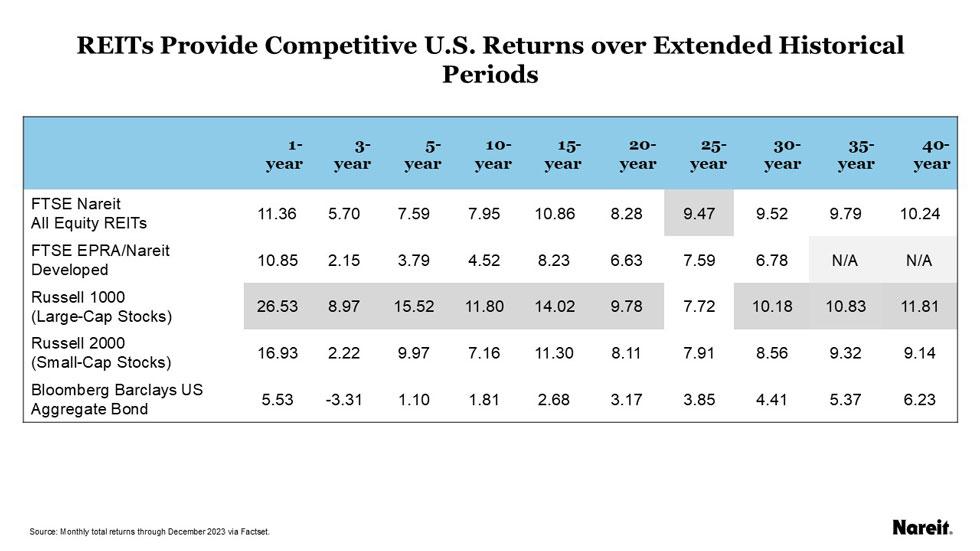A REIT is a company that owns, operates, or finances income-producing real estate REITs enable everyday Americans to benefit from owning shares in valuable real estate, and having access to dividend-based income and total returns.
REITs allow anyone to invest in portfolios of real estate assets the same way they invest in other industries – through the purchase of individual company stock or through a mutual fund or exchange traded fund (ETF). REIT stockholders earn a share of the income produced – without having to go out and buy, manage, or finance property themselves.
Approximately 170 million Americans live in households invested in REITs through their 401(k), IRAs, pension plans, and other investment funds.
What are the different types of REITs?
- Public REITs
Public REITs, usually referred to simply as REITs, are registered with the SEC and trade on national stock exchanges. - Public Non-listed REITs (PNLR)
PNLRs are registered with the SEC but do not trade on national stock exchanges. Liquidity options vary and may take the form of share repurchase programs or secondary marketplace transactions but are generally limited. - Private REITs
Private REITs are real estate funds or companies that are exempt from SEC registration and whose shares do not trade on national stock exchanges. Private REITs generally can be sold only to institutional investors.
The two main categories of REITs, in terms of the investments they pursue, are equity REITs and mortgage REITs, commonly known as mREITs.
- Equity REITs
Equity REITs generate income through the collection of rent on, and from sales of, the properties they own for the long-term. - Mortgage REITs (mREITs)
mREITs invest in mortgages or mortgage securities tied to commercial and/or residential properties.
What types of properties do REITs own?
Today, REITs invest in a wide scope of real estate property types, from more traditional sectors such as office, residential, lodging and retail to digital economy sectors that include logistics, data centers, and cell towers
In total, REITs of all types collectively own more than $4 trillion in gross assets across the U.S., with public REITs owning approximately $2.5 trillion in assets. U.S. listed REITs have an equity market capitalization of more than $1.3 trillion.
U.S. public REITs own an estimated 580,000 properties and 15 million acres of timberland across the U.S.
How do REITs make money?
Most REITs operate along a straightforward and easily understandable business model: By leasing space and collecting rent on its real estate, the company generates income which is then paid out to shareholders in the form of dividends. REITs must pay out at least 90% of their taxable income to shareholders—and most pay out 100%. In turn, shareholders pay the income taxes on those dividends.
mREITs (or mortgage REITs) don’t own real estate directly, instead they finance real estate and earn income from the interest on these investments.
Why invest in REITs?
REITs historically have delivered competitive total returns, based on high, steady dividend income and long-term capital appreciation. Their comparatively low correlation with other assets also makes them an excellent portfolio diversifier that can help reduce overall portfolio risk and increase returns. These are the characteristics of REIT-based real estate investment.
What are the ways to invest in REITs?
An individual may buy shares in a REIT, which is listed on major stock exchanges, just like any other public stock. Investors may also purchase shares in a REIT mutual fund or exchange-traded fund (ETF).
A broker, investment advisor, or financial planner can help analyze an investor’s financial objectives and recommend appropriate REIT investments.
How have REITs performed in the past?

REITs' track record of reliable and growing dividends, combined with long-term capital appreciation through stock price increases, has provided investors with attractive total return performance for most periods over the past 45 years compared to the broader stock market as well as bonds and other assets.
The past few years have not been without their challenges for REITs, but overall the industry has successfully weathered a global pandemic, higher interest rates, and stubborn inflation while maintaining enviable balance sheets and access to capital markets. REITs, on average, have outperformed both private real estate and the broader stock market during and after the last six recessions. For example, REIT total return performance over the past 20 years has outstripped the performance of the S&P 500 Index and other major indices–as well as the rate of inflation.
How do REITs compare to other real estate investments?
Research shows that over extended periods of time, REITs have outperformed other forms of real estate investments. For example, CEM Benchmarking’s 2024 study shows that between 1998 and 2022, REITs posted average returns of 9.7% compared with 7.7% for private real estate.